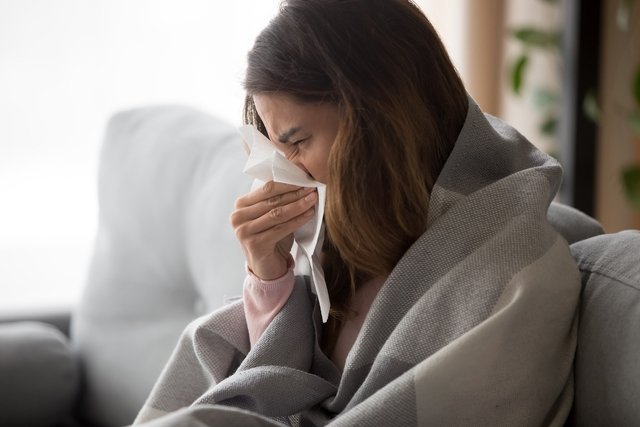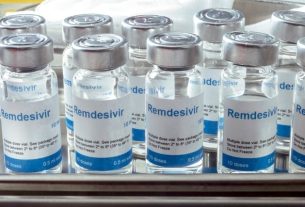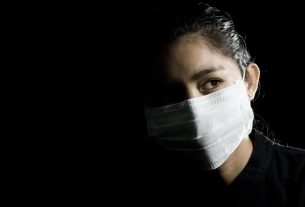The initial symptoms of COVID-19 are headache and body pain, tiredness, cough, runny nose or stuffy nose, which can appear up to 14 days after contact with the virus.
The symptoms of COVID-19 may vary from person to person, and may be milder, similar to the flu, or more serious, such as chest pain and shortness of breath, especially older people and/or those with chronic illnesses, such as diabetes, autoimmune diseases or cancer, for example.
If you have signs and symptoms of COVID-19, it is a good idea to get tested for COVID-19 and self-isolate to avoid transmitting the disease to other people.

Main symptoms
The main symptoms of COVID-19 are:
- Dry and persistent cough;
- Fever above 38º C;
- Excessive tiredness;
- Generalized muscle pain;
- Headache;
- Sore throat;
- Runny or stuffy nose;
- Changes in intestinal transit, mainly diarrhea;
- Loss of smell, known as anosmia, and taste, called dysgeusia.
Furthermore, due to the irritation of the airways caused by the infection, a feeling of itching or scratching in the throat and clearing of the throat may also occur. See other causes of throat clearing.
In some cases, it is also possible to notice changes in the fingers, popularly known as “covid fingers”, which can be painless or cause intense pain, itching, swelling and the appearance of blisters, in addition to rough skin, with elevations and a red or purple color. .
When do the initial symptoms appear?
The initial symptoms of COVID-19 can take between 2 and 14 days to appear, with excessive tiredness, headache and body pain usually being noticed.
As the symptoms of COVID-19 can be similar to those of the common flu, it is important to get tested to confirm or rule out a diagnosis of COVID-19. Understand how to differentiate the symptoms of COVID-19, flu or cold.
Online symptom test
If you think you may be infected, please answer the following questions to find out what your risk is and what to do:
The symptom test is only a guidance tool and does not serve as a diagnosis or replace consultation with an infectious disease specialist or general practitioner.
Difference in symptoms between COVID-19 and dengue
Both COVID-19 and dengue can cause some similar symptoms, such as fever, muscle pain or headache. However, they are generally more intense in cases of dengue fever.
Furthermore, while in COVID-19 it is common to experience difficulty breathing, dry cough, and a feeling of a runny or blocked nose, in dengue these symptoms are not present.
Other different symptoms are red spots on the body, pain behind the eyes and joint pain, which are common in dengue fever but do not occur in COVID-19, for example. Know how to identify all the symptoms of dengue.
How to confirm the diagnosis
The diagnosis of COVID-19 can be made by a general practitioner or infectious disease specialist and is normally initiated by evaluating the person’s symptoms and contact history.
However, the diagnosis can only be confirmed after a COVID-19 test using respiratory secretions or a blood test to confirm whether it is actually an infection with the new coronavirus or not. Depending on the type of test, results may take hours or days depending on the laboratory in which it is carried out. Learn more about COVID-19 testing.
If you’d like to speak to a doctor, use our appointment booking tool to find a GP near you:
Taking care of your health has never been easier!
In more serious cases, the initial symptoms worsen quickly, resulting in difficulty breathing, chest pain and confusion, for example. In these cases, the infection is considered serious and should be treated in the hospital as soon as possible.
The most serious symptoms of COVID-19 seem to appear especially in people over the age of 60 or who have some type of weakened immune system, as can happen in cases of autoimmune disease, chronic illness or transplants.
Main symptoms of each variant
Symptoms of SARS-CoV-2 infection may vary slightly depending on the variant responsible, and there may be more or less frequent and intense symptoms. In general, COVID-19 causes fever, cough, muscle and body pain and sore throat, however, other symptoms are more frequent when the infection occurs with a specific variant:
- Alfa: loss or change in smell or taste, loss of appetite and chills;
- Beta: excessive tiredness, vomiting and diarrhea;
- Gama: excessive tiredness, vomiting and diarrhea;
- Delta: headache, runny nose, constant sneezing;
- Ômicron: headache, runny nose, nasal congestion and excessive tiredness.
It is important to highlight that the person may present none, one or more symptoms of infection, in addition to that a person infected with the delta variant, for example, may also present changes in taste, despite this being more common in the case of infection with the variant. alpha. Therefore, it is important that laboratory tests are carried out to confirm the variant responsible for COVID-19. See more about COVID-19 variants.
How COVID-19 spreads
Coronavirus transmission occurs mainly through inhalation of droplets released into the air when coughing or sneezing. However, it is also possible to catch COVID-19 when you come into contact with an infected surface and then wipe your face, especially the mucous membranes of your eyes, nose or mouth. Learn about the main forms of transmission of COVID-19.
The risk of transmitting the disease appears to be highest in the two days before symptoms appear and in the 3 days after symptoms begin.
How the treatment is carried out
There is no specific treatment for COVID-19, and support measures are recommended, such as hydration, rest and a light, balanced diet.
In addition, medicines for fever and painkillers, such as Paracetamol, and medicines that can help improve immunity and combat symptoms are also recommended, as long as they are used under the supervision of a doctor, to facilitate recovery. See how treatment for COVID-19 is carried out.
In the most serious cases, in which the person has difficulty breathing, for example, it is important that they go to the hospital so that the most appropriate treatment can be initiated and vital signs can be monitored, and the administration of oxygen and the use of of specific remedies. Learn about the remedies for COVID-19.

Sign up for our newsletter and stay up to date with exclusive news
that can transform your routine!
Warning: Undefined array key "title" in /home/storelat/public_html/wp-content/plugins/link-whisper-premium/templates/frontend/related-posts.php on line 12
Warning: Undefined array key "title_tag" in /home/storelat/public_html/wp-content/plugins/link-whisper-premium/templates/frontend/related-posts.php on line 13



